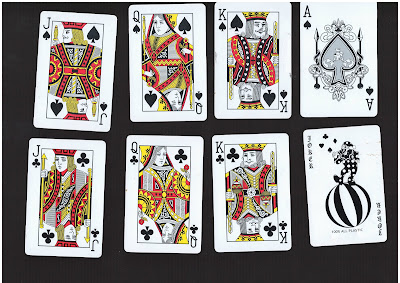"Chik Kee cards", 金星/Gold star , 159c,
( N.B: New edit as of 20th October 2017)
This deck of cards was found in an old shop in Singapore. It had probably laid there for several decades undisturbed, as the shop transformed from what was probably a general store to a dedicated lottery shop. When I spotted it, its fragile cellophane wrapper was nearly falling apart, and the edges of the cards brown. I gladly paid for it, even though shopkeeper inflated its price by several dollars.
This card is one of an extremely rare species of "money suited " cards. They apparently were once very common, but now have disappeared. The suit system is familiar to any player of mahjong. such cards have three suits, viz; coins, bamboos, (or in this case, strings of coins) , and myriads or
wan. Within each suit are nine ranks. In addition to these three basic suits, these cards typically include a set of extra cards, usually three or four in number.
This particular example is rather extraordinary, for two reasons. First, it incorporates colour in its designs. Second, its ranks structure is very unusual.
Most decks of money-suited cards have four copies of each card. This particular deck has
five copies of each card. ( embarrassingly , this fact escaped me for over a year!). The distribution of cards is as follows:
|
Suit
|
Ranks inside suit
|
Number of cards
|
|
Coins
|
Ace to Nine, 5 copies of each
|
45
|
|
Strings
|
Ace to Nine, 5 copies of each
|
45
|
|
Myriads
|
Ace to Nine, 5 copies of each
|
45
|
|
Odd cards
|
千, nine copies
|
9
|
|
|
老道 5 copies
|
5
|
|
|
白花 5 copies
|
5
|
|
|
金玉 5 copies
|
5
|
|
TOTAL
|
|
159
|
Here you see the suits of coins( top row) and myriads ( bottom row).
Note the ornately decorated ace of coins ( top row, 1st from right), and the small blossom on the seven of coins (Top row, 3rd from left)
The suit of myriads contains almost cartoon-like depictions of human figures. The Chinese inscription above each card shows its rank. The Nine of myirads ( Bottom row, 1st from left) shows a man holding a flag with the character 令-- A Military commander? The five of Myriads ( Bottom row, 5th from left) shows a man holding an axe standing beside a child.
For some reason, the captions of the 2. 3,4 and 7 are white on black, while the rest are black on white. Whatever significance this may have, I do not know.
The one, five, and nine are coloured in. This might have a role in the games played.
The suits of strings ( top row) and the bonus cards). The strings in question refer to the ancient Chinese practice of stringing together large quantities of coins by their central holes. As before, the ranks are from one to nine. The one of the suit is coloured. The nine of the suit has a bold red overprint, showing the Chinese character for nine.
The extra cards are on the bottom row. Translations of the inscriptions:
A: White flower
B: Golden Jade
C: Old Tao ( Perhaps a scholar or a Taoist priest-magician?)
D Thousand
E: The back of the cards. Worthy of op art.
It should be noted that the cards have a form of indices. The black rectangle on the top and bottom of the cards displays the suit, and rank of the card in question. You can see it in the following table:
The rank is marked by means of a simple geometric shape. For example, the twos have a small circle; the fives two small circles, and sixes have a pair of white rectangles.
The suit is represented by the presence of a semicircle. The suit of coins has no semicircle. The suit of strings has the semicircle on the bottom of the rectangle. The suit of myriads has the semicircle on the top of the rectangle.
The pack also includes a quality control certificate Although its inscription is much faded, I reproduce it below, with a translation.
If any reader can provide a better translation, I am happy to receive it.




























